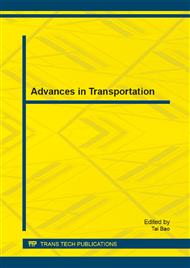[1]
Davol A P. Modeling of traffic signal control and transit signal priority strategies in a microscopic simulation laboratory [D]. Massachusetts Institute of Technology, (2001).
Google Scholar
[2]
Yuan-zhou Y., MAO Bao-hua, ZHANG Jian-peng, GAO Li-ping, CHEN Shao-kuan; Research on Signal Priority Simulation for Bus Rapid Transit Using Cellular Automaton Model [J][J]. China Journal of Highway and Transport, 2010, 5.
Google Scholar
[3]
Boxill S A, Yu L. An Evaluation of Traffic Simulation Models for Supporting ITS [J]. (2000).
Google Scholar
[4]
Papageorgiou G, Damianou P, Pitsillides A, et al. MODELLING AND SIMULATION OF TRANSPORTATION SYSTEMS: PLANNING FOR A BUS PRIORITY SYSTEM [J].
Google Scholar
[5]
Zhiyuan S, Huapu L, Jing W. Modeling and simulation of intersection signal control for transit priority[C]; Control and Decision Conference (CCDC), 2013 25th Chinese. IEEE, 2013: 4496-4501.
DOI: 10.1109/ccdc.2013.6561745
Google Scholar
[6]
LIU H, YANG Z. Research on the Signal Coordination Methodology in a Distributed Real-Time Network Signal Control System with Transit Priority [J][J]. Journal of Transportation Systems Engineering and Information Technology, 2007, 2: 019.
Google Scholar
[7]
Wei L Y, Wu R H, Zhang L L, et al. Study of Transit Priority Strategies on Intersection under Multi-Restrictions[J]. Applied Mechanics and Materials, 2013, 253: 1736-1740.
DOI: 10.4028/www.scientific.net/amm.253-255.1736
Google Scholar
[8]
Papageorgiou G, Maimaris A. Modelling, Simulation Methods for Intelligent Transportation Systems[J].
Google Scholar
[9]
Claypool D, Balakrishna M, Baumgartner K, et al. Architecture for the Modeling and Analysis of Rapid Transit[J].
Google Scholar
[10]
Golub, A. Brazil´s Buses: Simply Successful. University of California Transportation Center, USA, 2004, http: /www. uctc. net.
Google Scholar
[11]
Schramm, L.R., K. Watkins and S. Rutherford. Features that Affect Variability of Travel Time on BRT Systems. In Transportation Research Record: Journal of the Transportation Research Board, No. 2143, Transportation Research Board of the National Academies, Washington, D.C., 2010. pp.77-84.
DOI: 10.3141/2143-10
Google Scholar
[12]
Khasnabis S. NETSIM-Based Approach for Evaluation of Bus Preemption Strategies, In Transportation Research Record: Journal of the Transportation Research Board, No. 1554, Transportation Research Board of the National Academies, Washington, D.C., 1996. pp.80-89.
DOI: 10.1177/0361198196155400111
Google Scholar
[13]
Furth P.G. and T.H. J Muller. Conditional Bus Priority at Signalized Intersection: Better Service Quality with Less Traffic Disruption. In Transportation Research Record: Journal of the Transportation Research Board, No. 1731, Transportation Research Board of the National Academies, Washington, D.C., 2000, pp.23-30.
DOI: 10.3141/1731-04
Google Scholar
[14]
Wadjas Y. and P. G Furth. Transit Signal Priority along an Arterial Using Advanced Detection. In Transportation Research Record: Journal of the Transportation Research Board, No. 1856, Transportation Research Board of the National Academies, Washington, D.C., 2003, pp.220-230.
DOI: 10.3141/1856-24
Google Scholar
[15]
Alexander S. Control Strategies for Transit Priority. In Transportation Research Record: Journal of the Transportation Research Board, No. 1727, Transportation Research Board of the National Academies, Washington, D.C., 2000, pp.20-26.
DOI: 10.3141/1727-03
Google Scholar
[16]
Yang, M. Final Report on Urban Transit Planning of Yingtan (2011-2020), Southeast University, (2011).
Google Scholar
[17]
Karlsruhe, A.G. VISSIM 4. 30 User Manual. PTV, Germany, (2007).
Google Scholar
[18]
Berkhout, A. and J. Righolt. Chinese Driving Behavior in Nanjing Calibrating VISSIM parameters. www. projectnanjing2009. nl. Accessed March 7, (2010).
Google Scholar


